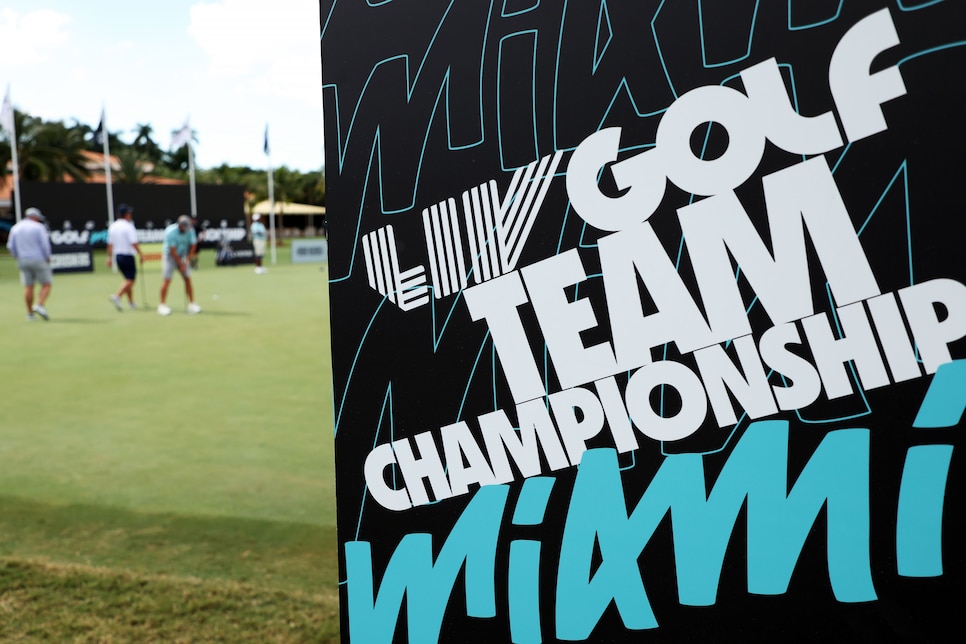[PHOTO: Icon Sportswire]
When Bryson DeChambeau’s Crushers GC won the LIV team final in Miami, the messaging from the tour about the $US14 million first prize had a subtle—but important—twist. Yes, DeChambeau, Anirban Lahiri, Charles Howell III and Paul Casey were generously rewarded for their performances, but 60 percent of the cash was allocated not to the players but to the Crushers team entity—of which DeChambeau owns an equity stake. LIV clearly wants to spread the message that the teams aren’t just marketing constructs. They’re brands with individual business models behind them.
The team aspect of LIV—and the ability to potentially sell teams to wealthy investors—is at the core of that model. The conceit? Another way top players like DeChambeau, Brooks Koepka (who owns a chunk of Smash GC) and Dustin Johnson (who owns a slice of Four Aces) were persuaded to make the jump to LIV was to grant them ownership stakes that would presumably go up in value as the teams began to generate revenue and become more popular. LIV owns majority stakes, but when teams are sold, players could either hold and collect recurring revenue or cash out some or all of that equity for another big payday.
How exactly would an interested investor evaluate a LIV franchise for potential investment? How would that potential investment compare to investing in other professional sports teams? Eric Coonrod and Matt Lashoff run Integral Ventures, a California-based advisory firm that helps investors evaluate opportunities like these. Coonrod says the team payout language is designed to telegraph to potential investors that LIV franchises go beyond hype and hope, and have potential revenue streams—and not just expenses such as flying players and their entourages around the world.
“The big questions at this stage are, ‘What kind of return can the investment provide in three, five or seven years?’” Coonrod says, “and, ‘Are you ready to jump in because you’re more afraid of missing out than you are of doing a proper valuation?'”
Assuming a client wants to buy into LIV as a business and not just an ego or passion play, Coonrod says due diligence would involve exploring the potential to grow revenue—and how much freedom teams have to do that within the structure of the league. Beyond team prizemoney, could Crushers GC cash in on DeChambeau’s fame for merchandising and sponsorship? What about building out a team facility where fans can attend events, watch practice rounds or even take a golf school “taught” by a tour player?
“If I’m advising a client who is considering buying in, I don’t think you want to look at this as a passive investment where you write a cheque, walk away and hope for the best,” Coonrod says. “This is an opportunity to actively participate in building something that could change the golf industry. There’s real work to be done building a brand, growing audience and attracting sponsors and broadcast exposure.”
More revenue is obviously nice, but the main spliff for a potential owner is the potential for that team to become more valuable for reasons unrelated to how many birdies DeChambeau makes or autographs Koepka signs. “Dan Snyder wasn’t the best NFL owner by many measures. The [Washington] team was not successful on the field, went through a challenging rebrand and became less popular in its market,” Coonrod says. “But because the NFL brand is so strong and there are so few opportunities to be an NFL owner, just holding onto the franchise for 20 years turned an $800 million investment into $6 billion when he sold the team this year. That has to be considered a win.”

Part of the calculus for a potential LIV team buyer: what happens if the LIV–PGA Tour agreement goes through? Can LIV teams then tap into the PGA Tour’s established sponsor and television pipelines and become household names? Those things make setting a potential sale price tricky, especially for trailblazers. “I’d want to be able to buy Team No.12, not Team No.1,” Coonrod says. “You can not only learn from the playbook of the other deals but apply what franchises like the NHL’s Golden Knights and WNBA’s Aces have done to become so important in their markets so quickly. You also have more time to see what might be happening relative to the PGA Tour. Jumping in early probably means a lower price and more upside, and waiting means having better data. The trick is to find the sweet spot.”
One competitor has clearly found the right message to attract the billionaire class. Tiger Woods and Rory McIlroy’s TGL golf league has sold franchises to Fenway Sports Group’s John Henry, hedge-fund billionaire and New York Mets owner Steve Cohen, Atlanta Falcons owner Arthur Blank and billionaire couple Serena Williams and Alex Ohanian. The price those groups paid for one of six franchises in the league that kicks off in January is undisclosed, but marketing documents say they’re each projected to collect more than $US2 million in revenue in year one and be cash flow positive before the second season.
LIV teams are playing for more prizemoney, but they likely have substantially more expenses than TGL teams, which are geographically based but all compete in the same league-owned arena in Florida. LIV teams also don’t have the built-in marquee value of the world’s most famous golfer as a brand leader. “I’d certainly categorise LIV as an early-stage investment,” Coonrod says. “You’re placing a bet on exceptional leadership, market disruption and growth potential. LIV is certainly showing early signs of all those things. You can compare it to, say, cryptocurrency. It seems cool now. People want to be a part of it, and it could provide a huge return, but there are significant risks. I suspect the people who end up taking that gamble aren’t going to be ones who’ll have trouble paying their bills if it doesn’t work out.”



